- The Science of White Teeth and Attraction
- How does teeth whitening work?
- Dentin
- Modern Teeth Whitening Treatments
- Off-the-Shelf and At-Home Dental Whitening Products Toothpaste
- Professional Teeth Whitening Treatments
- Thoughts Around Teeth Whitening Strategies Professional Teeth Whitening vs. At-Home Whitening
- Which teeth whitening system works best for you?
- Lifestyle and holistic teeth whitening strategies
What’s the first thing you notice about another person? Is it their eyes? Is it their physique? Or, as science seems to support, is it their smile?
Appearance plays an overwhelmingly decisive role in informing how we see others and how others see us, at least initially. Moreover, one of the most significant components of this initial visual impression is your smile. Small wonder then that improving, enhancing, or even completely remaking one’s smile is not only highly desirable, but it’s also extremely commonplace. In the US alone, about $1 billion per year is spent on cosmetic dental procedures.
Millions of people put their children through the misery of orthodontic treatment regimens in their teen years, typically with braces, so that their children can have perfect smiles as adults. They understand the immense value of investing in cosmetic dentistry can have. A beautiful, attractive smile will help their children’s self-confidence, improve their social lives, enhance the likelihood of landing a great job, and even help them attract a lifelong partner and mate.
“Modern whitening treatments can be divided mainly into two broad categories – treatments that focus on removing extrinsic staining and treatments aimed at affecting the dentin itself.”
Of course, in pursuit of a perfect smile, braces (Clear Braces) and other straightening treatments are but one component. Dazzling white teeth are the hallmark of a beautiful smile.
Everyone wants to have whiter teeth. With readily available over-the-counter pastes, gels, lights, trays, and other equipment, attaining whiter teeth has never been easier. In fact, clinical dental whitening is probably the easiest, least invasive, and the most effective way to professionally improve and enhance your smile. However, a wide range of options also breeds consumer confusion.
Which teeth whitening treatment will work best for me?
How much will it cost? Do they even work?
How exactly does the teeth whitening process work?
These are but a handful of the questions most consumers have. While brilliant white teeth are desirable, getting the best results is much more difficult.
In a world rife with misleading marketing, overhyped products, and overblown claims, it’s easy to feel overwhelmed. That’s where patient education comes in. Since you’re reading this article, you’re already off to a great start.
My objective is to educate you by taking you through the ins and outs of the dental whitening process, including not only how professional whitening treatments work but also relevant and useful information about at-home treatments, over-the-counter products, holistic therapies, and alternative treatments.
The Science of White Teeth and Attraction
People find perfect, white teeth to be attractive.
Explaining the science behind why human beings are so enamored of this one particular dental quality is much more difficult. The working theory goes something like this:
Dental quality (i.e., white teeth) acts as a psychological signal to potential mates about the age, health, and vitality of a particular individual. Crooked, yellow teeth are associated with poor health and poor hygiene.

Likewise, discolored teeth may also indicate someone who is older, weaker, and less potent. Of course, teeth are so much more than just a mere visual cue for potential mates. They also act as ornaments. You can literally “wear” your smile like a beautiful, dazzling, and brilliant piece of jewelry.
How does teeth whitening work?
To understand the underlying process behind dental whitening, it is essential to know about the structure of your teeth. The outer layer of a tooth is known as the enamel. While it is visible and exposed for all to see, it is only partially responsible for dental coloration.
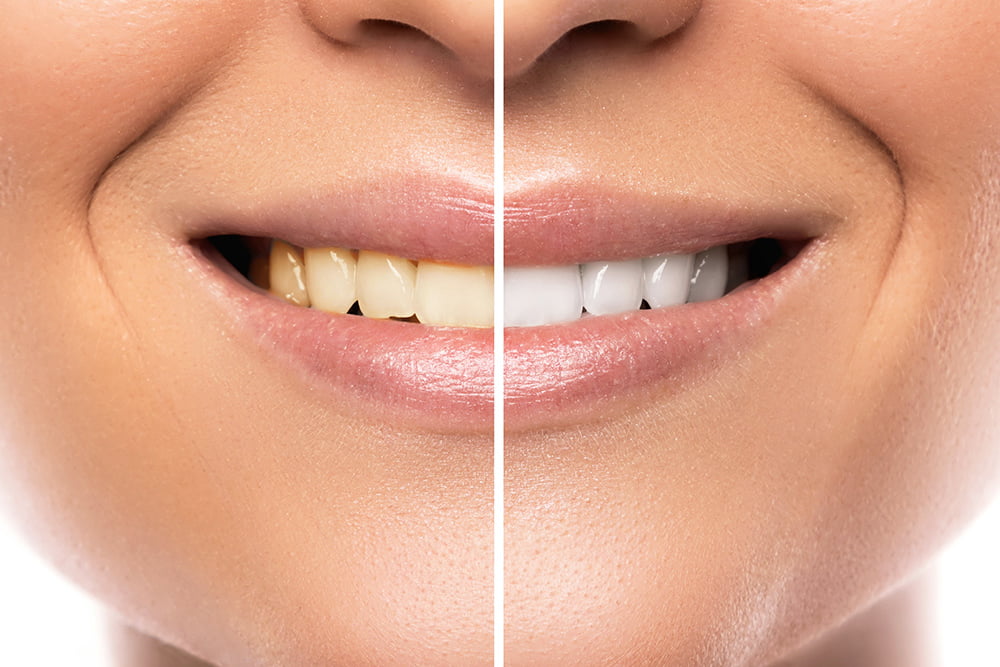
Dentin
Right underneath the enamel is the dentin. Dentin is naturally yellowish. The coloration of natural teeth is mostly the dentin showing through the translucent enamel. That’s what gives healthy teeth a slightly off-white hue. Therefore, dental coloration is not only determined by the color of the enamel but also the dentin beneath the enamel.
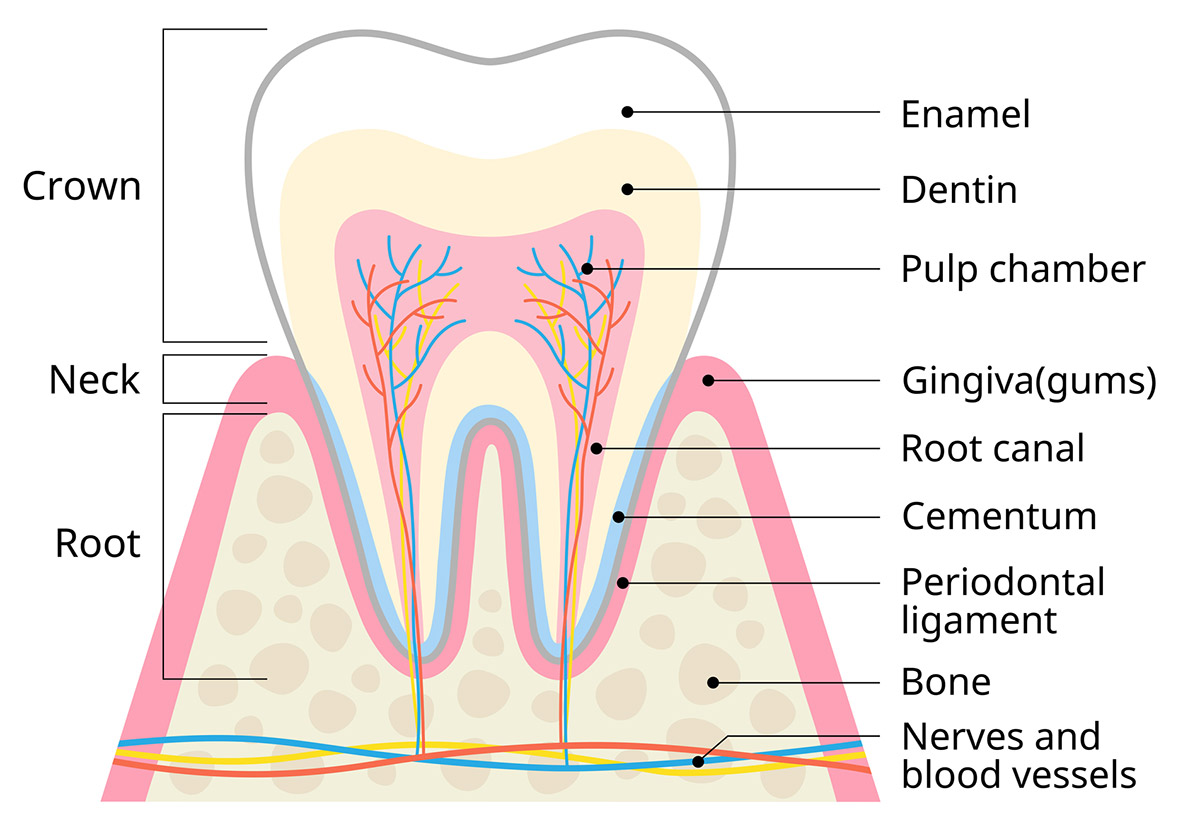
Because dental enamel is exposed, it is vulnerable to extrinsic staining. What that means is that the enamel itself can be physically discolored by staining agents such as the tannins found in colored beverages such as coffee or wine, or the gradual infiltration of staining agents into the enamel matrix thanks to biofilm, bacteria, and enamel erosion. It is important to note that the gradual wearing away of enamel can also result in visible discoloration as yellower dentin is revealed beneath the enamel.
Discoloration, due to the condition of the dentin, is known as intrinsic staining. Intrinsic staining beneath the enamel is often not the result of exposure but rather the consequence of factors that are systemic and difficult to control, such as genetics, medications, fluoride exposure, and environmental circumstances.
Modern Teeth Whitening Treatments
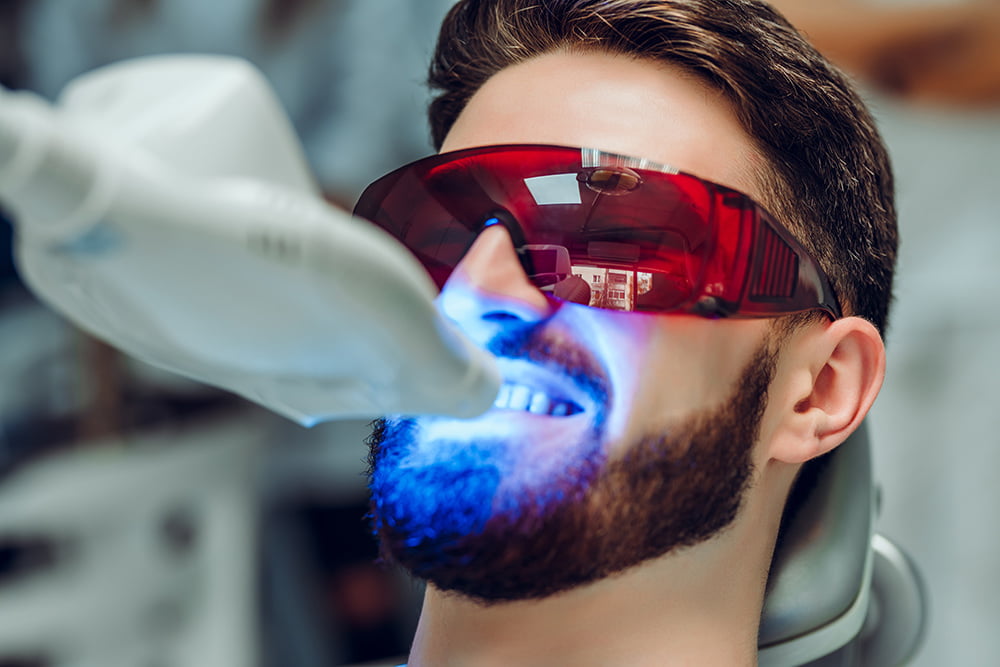
Modern whitening treatments can be divided mainly into two broad categories – treatments that focus on removing extrinsic staining and procedures aimed at affecting the dentin itself.
In the former falls general dental hygiene and cleaning services and products aimed at removing and reducing enamel-destroying bacteria and extrinsically staining substances.
In the latter falls, peroxide-based treatments rely on chemicals such as hydrogen peroxide to alter the underlying dentin chemically. To achieve a long-lasting and natural-looking result, both approaches are recommended. Both extrinsic and intrinsic staining must be addressed to get a brilliant white smile.
Extrinsic whitening methods are widely understood. Physically removing staining pigments, such as darkening tannins, will lead to whiter brighter teeth. Likewise, eliminating bacterial biofilm, also known as plaque, tartar, and calculus, will reduce and reverse enamel erosion.

Remember, enamel is translucent, which means decreasing its natural thickness will expose the yellower dentin underneath, leading to visible discoloration. To avoid thinning the enamel and exposing the dentin, you should avoid exposing your teeth to eroding acids or physical trauma.
Intrinsic whitening is a little more abstract, and it typically is what patients and dentists are generally referring to when they talk about “dental whitening.”
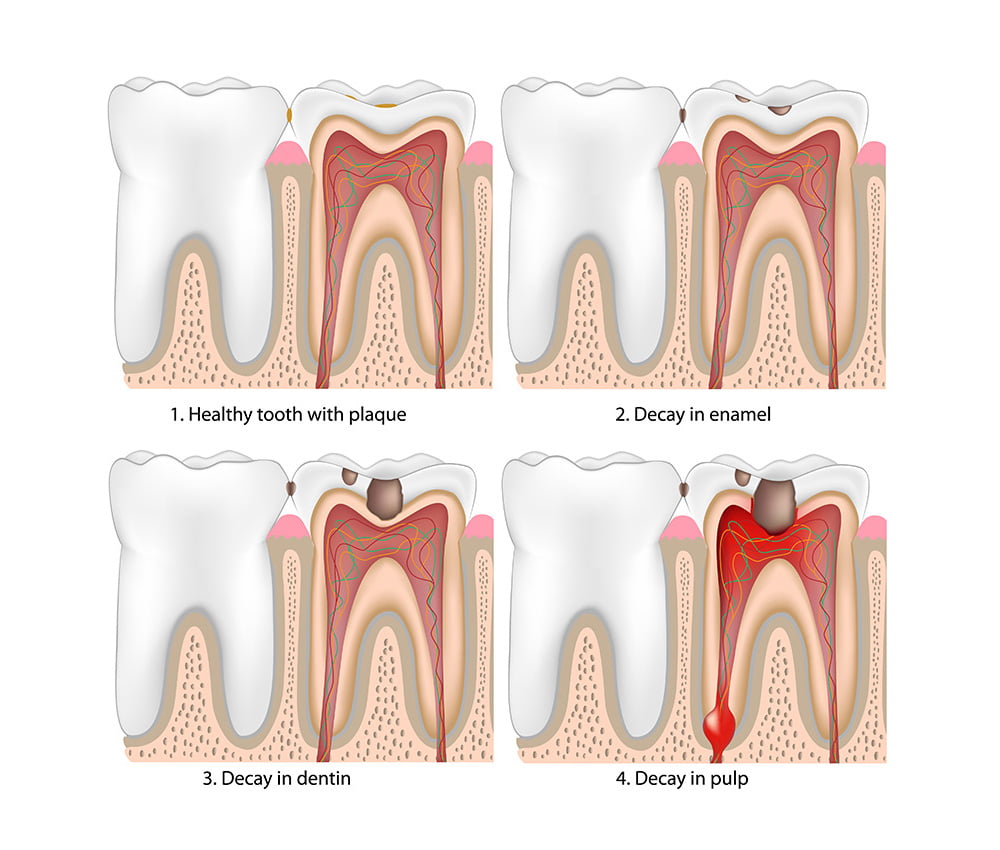
Dentin contains color molecules known as chromophores, which reflect light in a way that makes the dentin look darker than the enamel. These chromophores also tend to bond together, resulting in a gradual darkening of the dentin, which gives teeth a yellow hue. To combat this, dentists and some off-the-shelf products utilize peroxide-based treatments to break up bonded chromophores chemically. This results in noticeably whiter-looking teeth.
Off-the-Shelf and At-Home Dental Whitening Products Toothpaste
1. Toothpaste
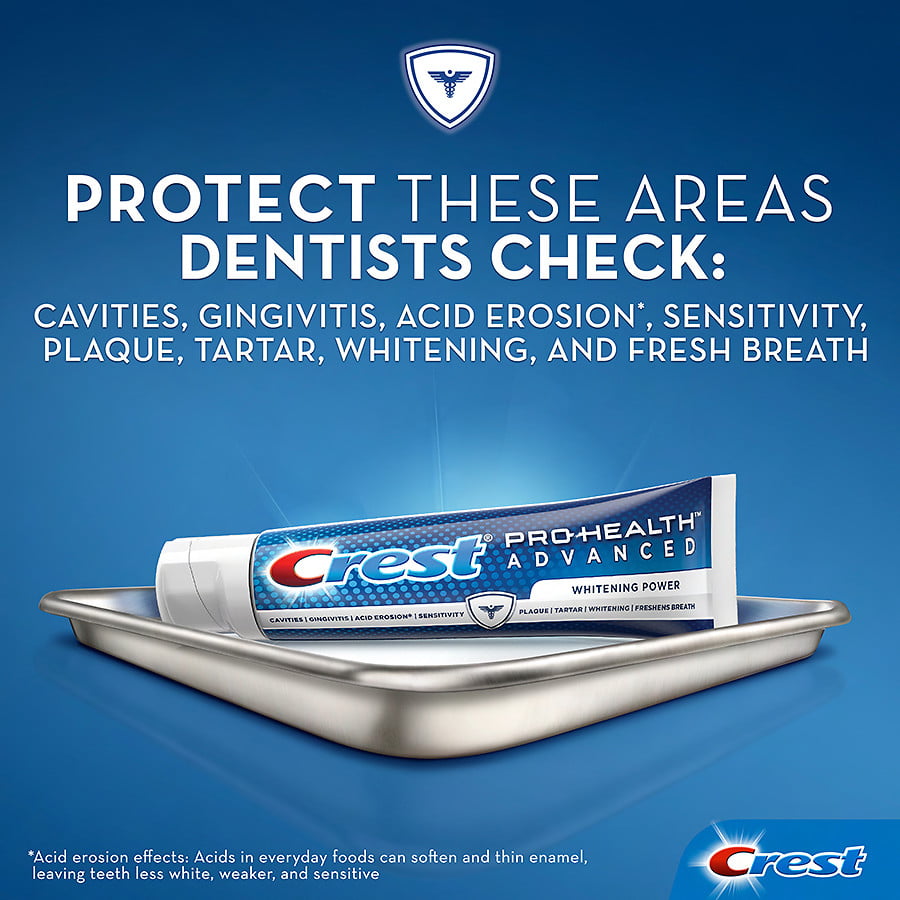
Toothpaste products claiming to whiten teeth are everywhere and easy to find. In fact, it may be harder for consumers to find a toothpaste that does not claim to provide some whitening action. Buying a whitening toothpaste is by far the easiest, most accessible, and most affordable form of dental whitening treatment available to consumers.
Mostly, whitening toothpaste products rely on surface action to remove extrinsic surface stains. Many toothpaste products formulated explicitly to whiten teeth contain harsh ingredients, such as silica, that mechanically scrub away staining agents. As a result, whitening toothpaste products generally have little effect on the natural coloration of a person’s teeth. Many consumers find that the claims found on the toothpaste packaging, while technically correct, tend to underwhelm.
Results from using specially formulated whitening toothpaste products generally take months to manifest and must be accompanied by good dental habits such as avoiding coffee, wine, and other staining agents.
2. Dental whitening strips
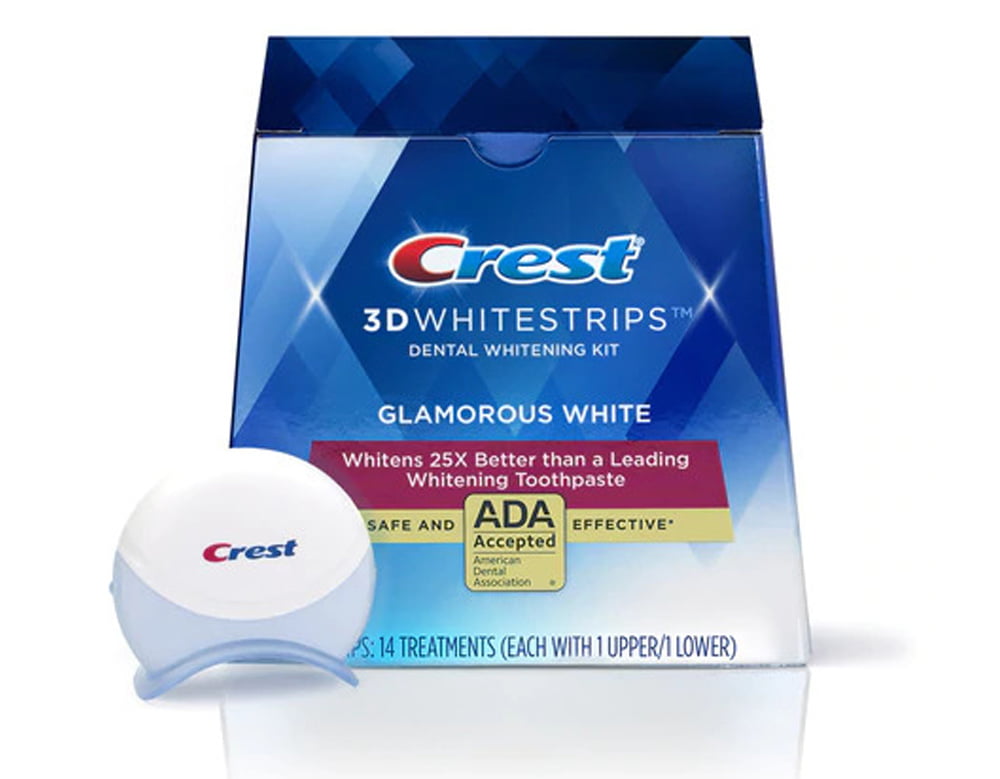
Whitening strips are the second most popular option for at-home dental whitening after whitening toothpaste products. Dental whitening strips can be found at your local grocery store or pharmacy. It’s also becoming popular with subscription plans from online providers. While more expensive than whitening pastes, they are also far more effective, with patients seeing a noticeable lightening of their teeth within three to seven days, with results lasting as long as six months with adequate dental care.
Dental strips consist of two flexible plastic strips that are applied to the teeth for a period of time. The strips are often coated with hydrogen peroxide or a peroxide derivative that can remove intrinsic dental staining.
3. Teeth whitening gels and trays
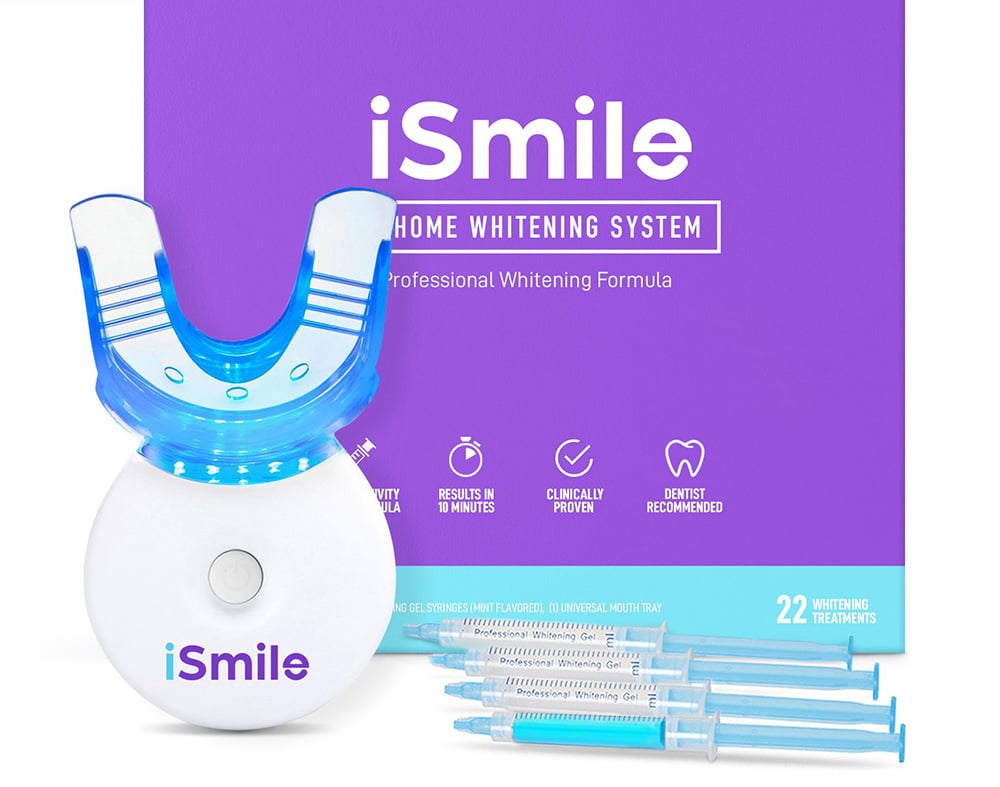
Teeth whitening gels, which are typically utilized in conjunction with a tray, are the next logical step up from dental whitening strips.
Gels should be used with caution. Unlike most off-the-shelf dental strips, gels often contain a higher percentage of hydrogen peroxide or carbamide peroxide and are often in contact with teeth for a more extended period of time. When used with ill-fitting trays, hydrogen peroxide can irritate gums.
When using gels with an at-home tray application, be sure to follow the manufacturer or supervising dentist’s recommended application time to avoid unnecessarily damaging your gums and soft tissues.
Due to the stronger nature of gels and the longer contact time with teeth, results are often noticeable within days. Like other peroxide-based treatments, gels remove intrinsic staining which makes teeth shine brighter for more extended periods of time.
4. Teeth whitening pens
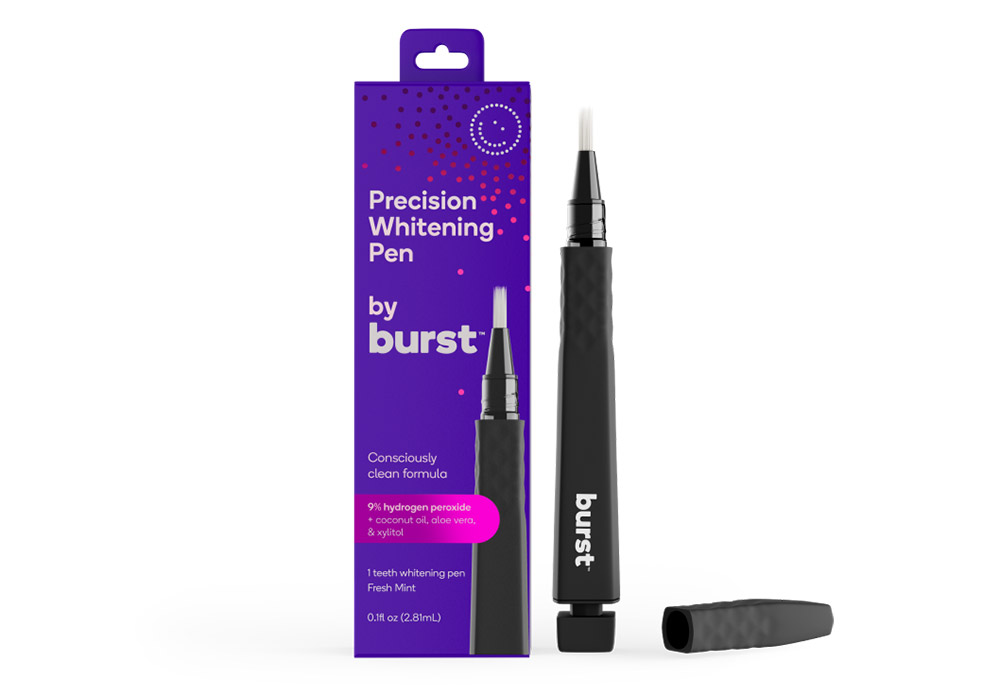
Teeth whitening pens are convenient and pocketable implements containing peroxide-based gels (typically 10% carbamide). They are designed to be applied to each tooth quickly and discreetly to remove stains on the go.
While trayless, teeth whitening pens do not provide the whitening power of dental whitening strips or tray-applied gels because the peroxide film applied by the dental whitening pen usually does not last long on the surface of the teeth. It is easily rubbed off or dislodged by consuming food and drink or by the natural rubbing of the inner mouth on dental surfaces. In other words, dental whitening pens are a nice, portable, quick fix but they are not a long-term whitening solution.
5. Teeth whitening kits with LED lights
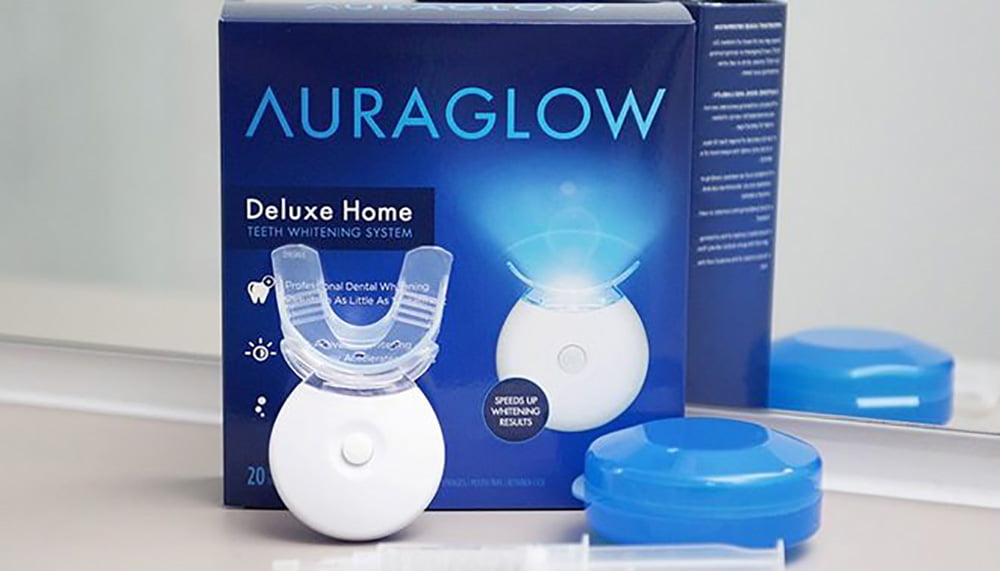
Teeth whitening kits with LED lights are a recent craze in the at-home dental whitening market. However, before you jump on the bandwagon, it is vital to understand what you are paying for. LED lights do not, in and of themselves, whiten teeth. Instead, they are intended to accelerate the bleaching properties of peroxide gels.
Do whitening kits with LED lights work?
The answer seems, at least based on the science as it stands today, to lean towards “no.” There have been studies that have shown marked whitening improvement with LED light-based treatments. However, there have been far more studies that show LED lights either made little difference or no difference whatsoever. The consensus is that whitening kits with LED lights may help accelerate the bleaching process but may not be worth the costs.
Professional Teeth Whitening Treatments
Clinical whitening sessions are typically much more involved than at-home, self-directed therapy. The process usually takes a few sessions or visits to your dental clinic, although it is possible to complete an entire whitening regimen in a single visit.
1. Touch-up teeth cleaning
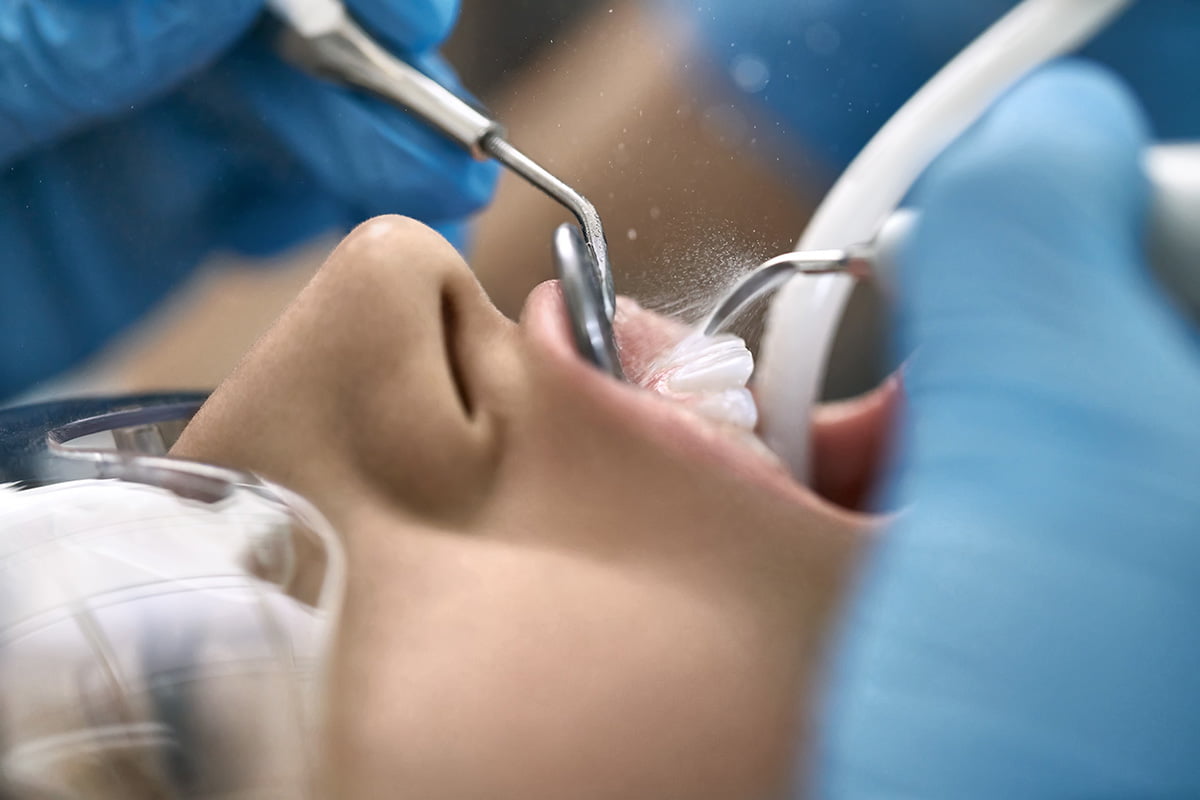
The teeth whitening process begins with a touch-up teeth cleaning. This is not as in-depth as a regular teeth cleaning at your dentist. The goal is to ensure the teeth are clean and stain-free.
2. Analyze the shade and coloration
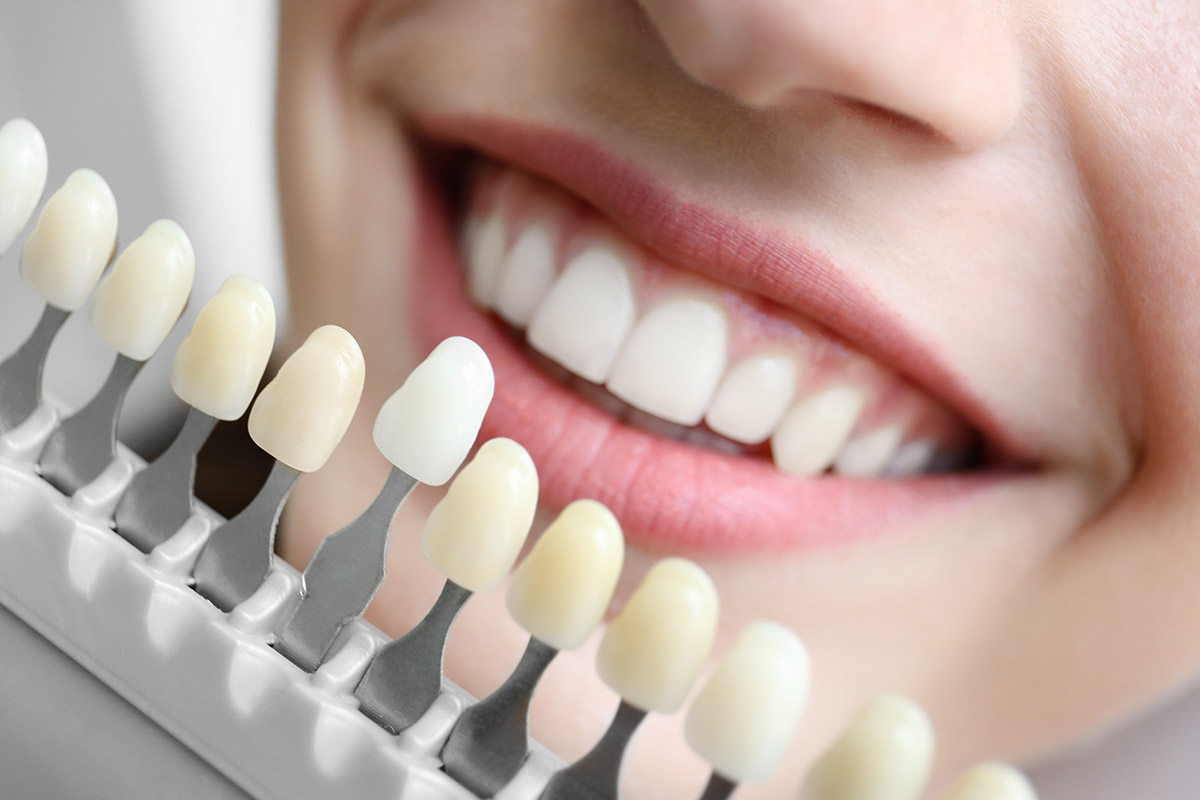
The dentist will first thoroughly examine the current shade and characteristics of all your teeth under proper lighting against shade termination tools such as what is shown in the above image.
In Step 1, external stains on the teeth have been cleaned or addressed by the dentist. Stains may influence shade perception so it’s important for a clean tooth surface so the underlying tone is visible.
Special standardized shade guides with bleach shade notation are matched against teeth areas to pick the current overall color across dimensions of brightness, hue and chroma.
The desired goal shade is chosen by the patient, indicating how many levels the teeth must change to create a uniform appearance.
Getting the shade selection perfect pre- and post-treatment ensures the desired transformation goal to a brighter uniform color is safely achieved for patient satisfaction.
3. The teeth are prepared for whitening.
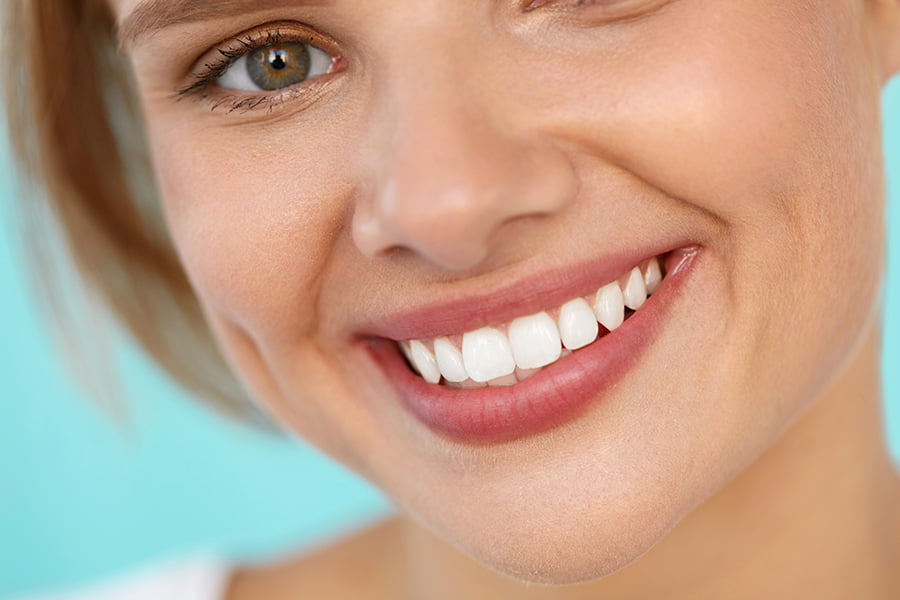
Once the baseline tooth shade is determined and the target number of shade levels to lift is agreed upon, the dentist will prepare the patient’s teeth for the actual whitening procedure. This typically involves:
Following this standard preparation protects surrounding tissues while confining gel activation strictly to the enamel of the teeth to safely and effectively achieve desired lift without harming other areas within the mouth or teeth.
4. Dental dams are applied.
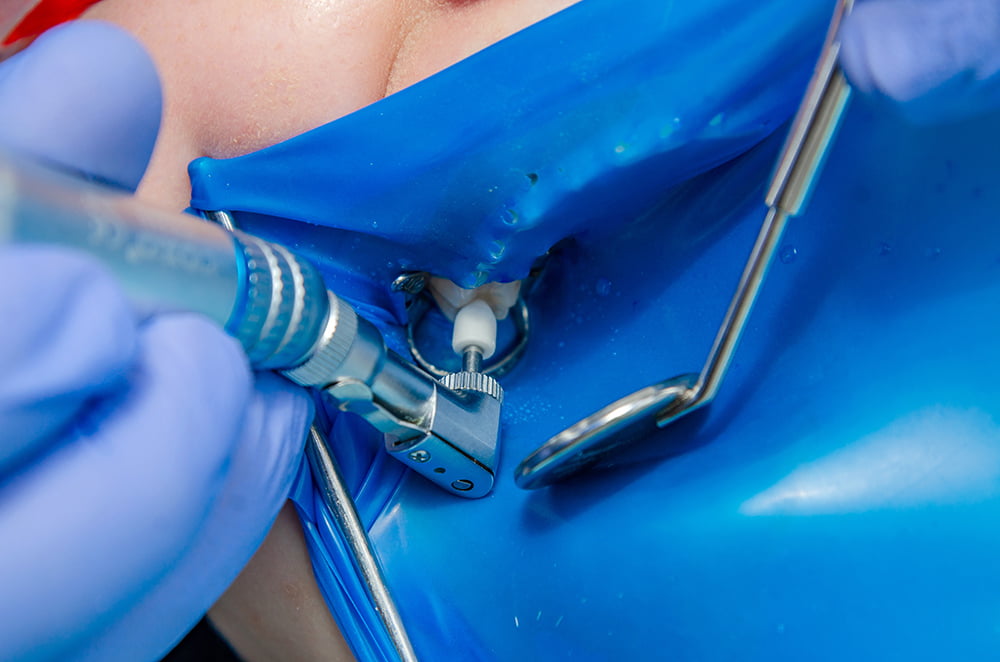
A dental dam is used to isolate the teeth undergoing the teeth whitening treatment. A dental dam is a thin sheet of non-latex rubber designed to protect the teeth from the whitening procedure. The dam is stretched over the target teeth with edges extended onto the surrounding gum areas.
The dam gets retained in position either by dental clamps wrapped around adjacent teeth, or by a special seal-ring adhesive placed over the gums. This helps secure the dam in place.
Exposed tooth surfaces get dried completely. Whitening gel is applied safely onto the teeth either before or after the dam without risk of sensitivity since the gel is blocked from contacting gums or skin.
After the bleaching session finishes, the dental dam and clamps get removed to reveal the brightened smile.
So, in essence, the dental dams restrict whitening gels only to the intended tooth enamel while protecting gum tissues and allowing higher-strength cleaning formulas while minimizing sensitivity risk to the teeth.
5. Professional-grade hydrogen peroxide is applied.
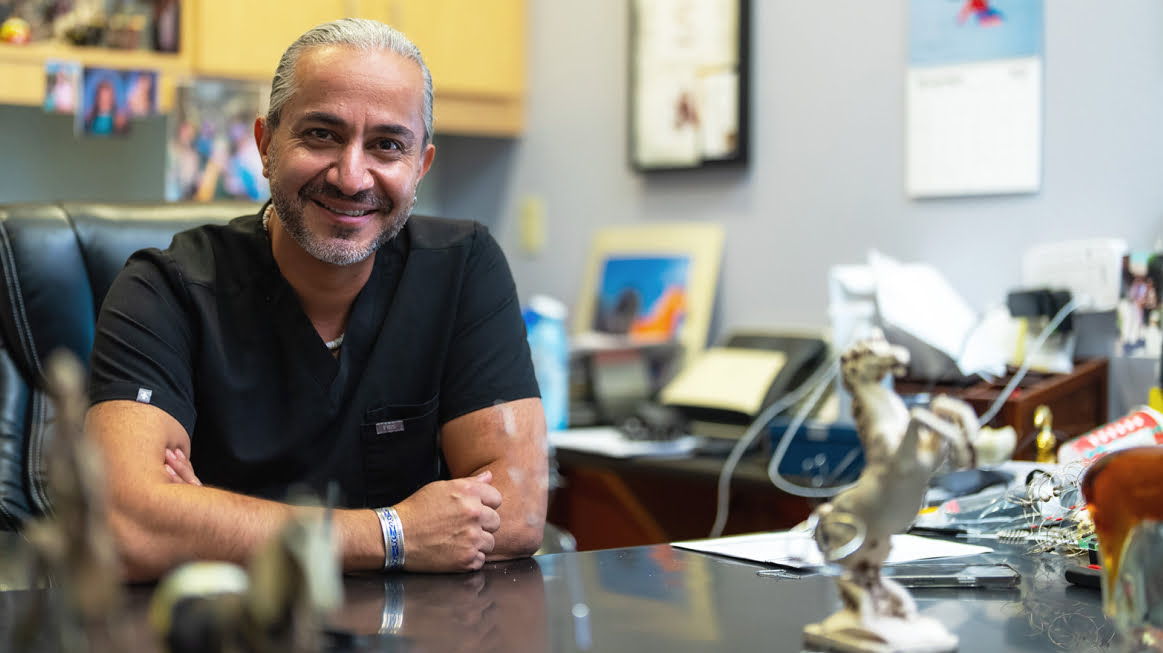
Once the dental dam is put in place and hardened using a unique light, the dentist applies a professional-grade hydrogen peroxide whitener. These super-strong peroxides can range in concentration from 15 percent to as much as 50 percent.
In comparison, at-home bleaching gel concentrations are typically 10 percent and sometimes less.
Many whitening solutions use carbamide or hydrogen peroxide to oxidize organic stains within the enamel layer through a chemical reaction over 30-60 minutes.
During this crucial window, as molecules penetrate micropores, eliminating intrinsic coloration, some dental professionals use specialized high-intensity light to activate and sustain photochemical reactions accelerating results. However, consensus still debates whether light systems contribute significantly better efficacy. Results vary case by case and product chemistry. But undeniably patients perceive a highly technical “turbo boost”.
Regardless of light integration, most initial whitening sessions last 10-20 minutes followed by fresh gel reapplications in cycles. As oxygen molecules expand lifting stains, dramatic shade jumps happen quickly. Maintaining oversight until the target shade emerges ensures both effectiveness and dental health simultaneously.
With time and chemistry alone already effective, smart whitening techniques amplify transformations beautifully without overdoing the removal of finite enamel layers better conserved.
6. Teeth are rinsed and dental dams are removed.
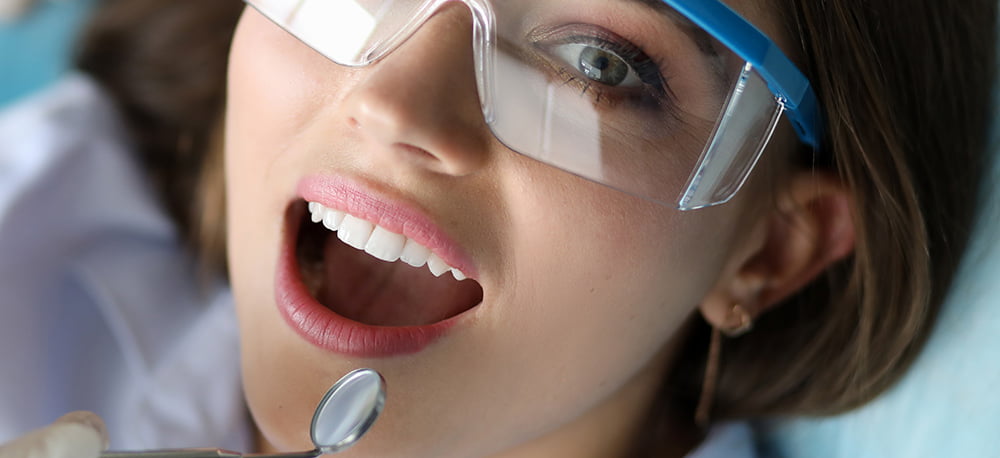
As the allotted treatment timeframe expires depending on the formula used, the administering dental professional thoroughly rinses off any remaining whitening gel residue from the teeth surfaces using water irrigation and vacuum suction. This clears away chemicals entirely down to the clean enamel.
Next protective isolation barriers like dental dams are removed gently to reveal the uncovered brightened smile.
The dentist will examine the gingiva for sensitivity and inspect the teeth using the original baseline shade guides to validate that adequate uniform lifting occurred free of irregularities.
Reference photos are repeated matching earlier positioning.
The patient is briefed to avoid stain-causing foods for 48 hours to allow full hardening as pores continue sealing. A follow-up checkup will be arranged to confirm the sustained stability of the achieved results.
Maintaining caution both during and briefly after whitening ensures patients heal smoothly towards brilliant aesthetics durably keeping stains dormant.
The treatment process is now completed.
7. Finishing application of fluoride is performed by the dentist.
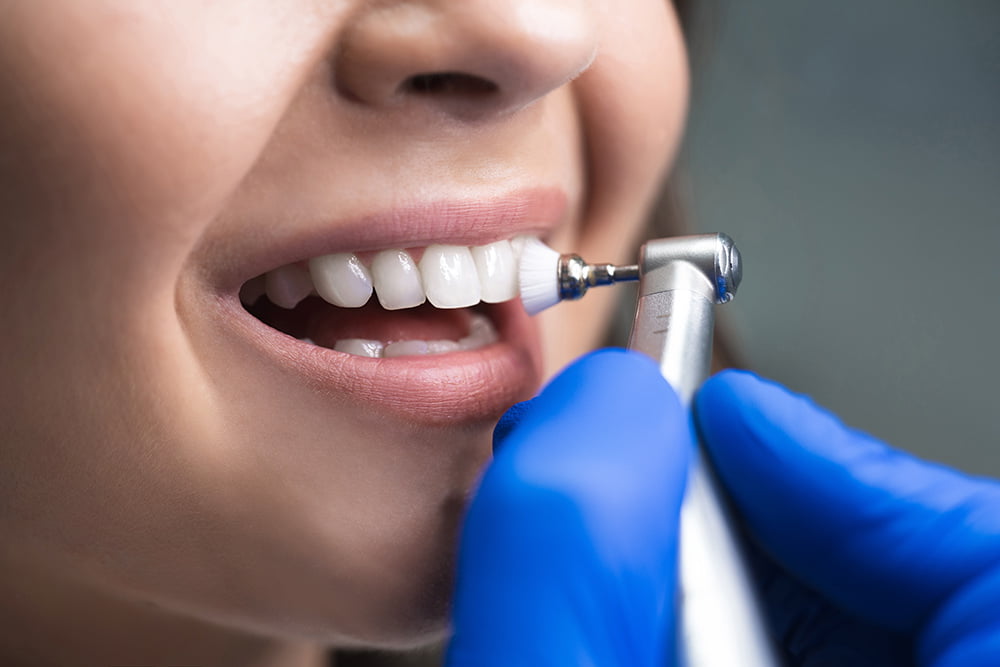
If sensitivity does present initially, fluoride treatments provide comfort while remineralizing any microscopic enamel surface depletion from intense oxidation. Some dentists recommend a finishing application of fluoride to help reduce dental sensitivity and help protect the patient’s newly whitened teeth.
Fluoride boosts acid resistance and strengthens vulnerable enamel after acid exposure from peroxide oxidation opens microscopic pores critical for stain removal.
Fluoride molecules also diffuse into lift-generated channels within enamel, essentially re-calcifying softened areas helping halt new stain formation and temperature sensitivities through barrier strengthening.
Fluoride also enhances mechanical durability. Protein integration makes the tooth enamel five times more crack-resistant, so the newly created porous zones don’t fracture under chewing stresses during the first couple of weeks as pores continue closing.
Fluoride also prevents sensitivity from nerve irritation from bleaching chemical remnants still present in opened enamel that is negated by insulating tubules with fluoride quickly achieving patient comfort.
The strengthened enamel surface retains shade better between appointments before long-term hardness fully restores through final remineralization weeks later.
Therefore fluoride washes act as the ideal finishing catalyst for your white teeth.
Thoughts Around Teeth Whitening Strategies Professional Teeth Whitening vs. At-Home Whitening
Both professional teeth whitening in a dentist’s chair and self-guided whitening at home are options for patients seeking to brighten up their smiles. Ultimately, both approaches have advantages and disadvantages that should be taken into account when making a decision.
Which teeth whitening system works best for you?
In general, patients with a larger budget and less time should seek professional whitening.
At-home dental whitening treatments are an option for individuals with a limited budget and patience to wait for weeks to months to observe results. However, it is important to note that these treatments generally yield less desirable outcomes compared to professional teeth whitening. Additionally, patients should consider their own ability to independently manage the treatment and adhere to a recommended treatment plan.
To achieve desired outcomes with an at-home treatment, users need to exhibit consistent dedication, adhere closely to instructions, and ensure punctuality for each treatment session.
Dental patients who undergo teeth whitening procedures at a dental clinic like Willow Pass Dental Care typically experience immediate and significant improvement. They can have peace of mind knowing that their treatment planning and execution are in the hands of well-trained dental professionals who strive for optimal outcomes.
Lifestyle and holistic teeth whitening strategies
Maintaining or gradually whitening your teeth naturally doesn’t always require direct chemical whitening treatments. Instead, most dentists suggest a balanced combination of extrinsic, intrinsic, and holistic strategies to help support, preserve, and actively brighten your smile.
Lifestyle changes can be one of the easiest, most cost-effective ways to whiten your teeth or protect your whitening investment. Simply avoiding staining beverages such as coffee and wine can go a long way towards preserving your white teeth. When drinking beverages, especially acidic beverages such as fruit juices and sodas, using a straw does wonders for your teeth.
Other lifestyle changes that can play a role in your whitening include eating a healthy diet, getting enough sleep, routine dental checkups, teeth cleanings, and exercising daily. A healthy body means healthy teeth. Our teeth are intimately connected to and affected by the rest of our body. Maintaining good health means that our teeth will have the nutrients they need to build enamel, fight off bacterial infections, and keep healthy bone density.
Watching what you eat and maintaining good health is, by far, the most economical, most effective, holistic, and the best way to improve your smile and your teeth.
 Written by Dr. Reza Khazaie
Written by Dr. Reza Khazaie